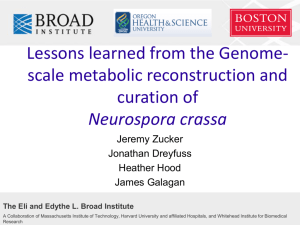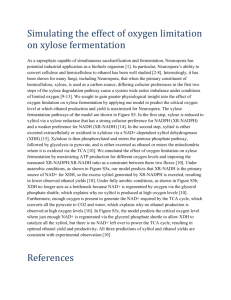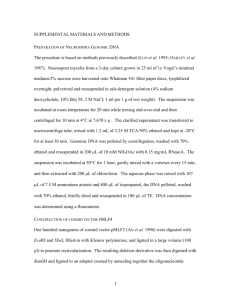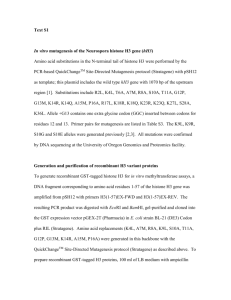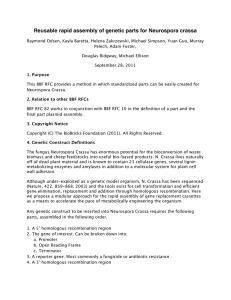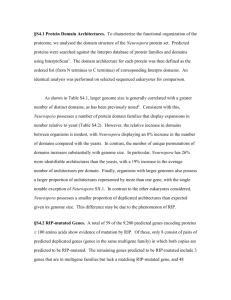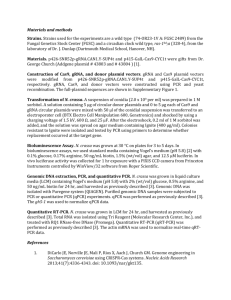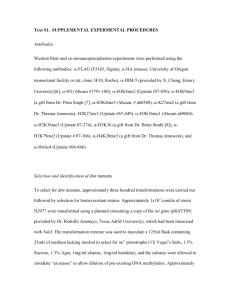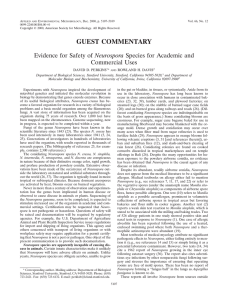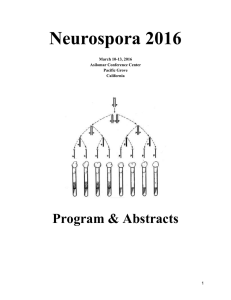Commentary Circadian rhythm in the pink–orange bread mould Neurospora crassa
advertisement
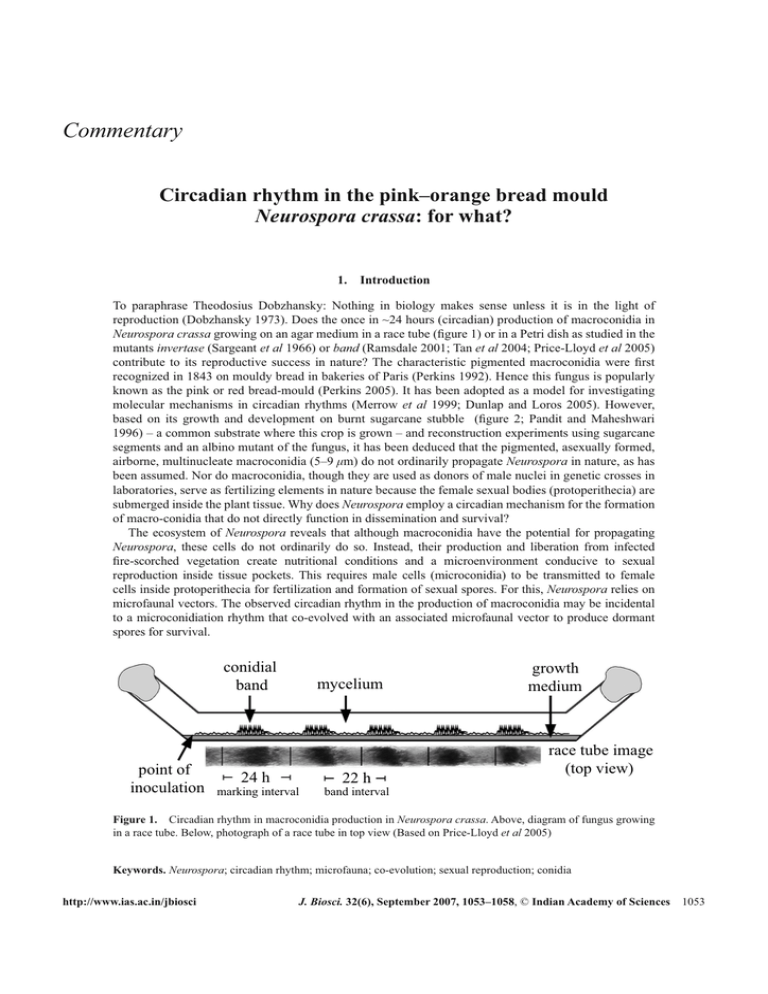
Commentary Circadian rhythm in the pink–orange bread mould Neurospora crassa: for what? 1. Introduction To paraphrase Theodosius Dobzhansky: Nothing in biology makes sense unless it is in the light of reproduction (Dobzhansky 1973). Does the once in ~24 hours (circadian) production of macroconidia in Neurospora crassa growing on an agar medium in a race tube (figure 1) or in a Petri dish as studied in the mutants invertase (Sargeant et al 1966) or band (Ramsdale 2001; Tan et al 2004; Price-Lloyd et al 2005) contribute to its reproductive success in nature? The characteristic pigmented macroconidia were first recognized in 1843 on mouldy bread in bakeries of Paris (Perkins 1992). Hence this fungus is popularly known as the pink or red bread-mould (Perkins 2005). It has been adopted as a model for investigating molecular mechanisms in circadian rhythms (Merrow et al 1999; Dunlap and Loros 2005). However, based on its growth and development on burnt sugarcane stubble (figure 2; Pandit and Maheshwari 1996) – a common substrate where this crop is grown – and reconstruction experiments using sugarcane segments and an albino mutant of the fungus, it has been deduced that the pigmented, asexually formed, airborne, multinucleate macroconidia (5–9 μm) do not ordinarily propagate Neurospora in nature, as has been assumed. Nor do macroconidia, though they are used as donors of male nuclei in genetic crosses in laboratories, serve as fertilizing elements in nature because the female sexual bodies (protoperithecia) are submerged inside the plant tissue. Why does Neurospora employ a circadian mechanism for the formation of macro-conidia that do not directly function in dissemination and survival? The ecosystem of Neurospora reveals that although macroconidia have the potential for propagating Neurospora, these cells do not ordinarily do so. Instead, their production and liberation from infected fire-scorched vegetation create nutritional conditions and a microenvironment conducive to sexual reproduction inside tissue pockets. This requires male cells (microconidia) to be transmitted to female cells inside protoperithecia for fertilization and formation of sexual spores. For this, Neurospora relies on microfaunal vectors. The observed circadian rhythm in the production of macroconidia may be incidental to a microconidiation rhythm that co-evolved with an associated microfaunal vector to produce dormant spores for survival. conidial band point of inoculation mycelium 24 h 22 h marking interval band interval growth medium race tube image (top view) Figure 1. Circadian rhythm in macroconidia production in Neurospora crassa. Above, diagram of fungus growing in a race tube. Below, photograph of a race tube in top view (Based on Price-Lloyd et al 2005) Keywords. Neurospora; circadian rhythm; microfauna; co-evolution; sexual reproduction; conidia http://www.ias.ac.in/jbiosci J. Biosci. 32(6), September 2007, 1053–1058, © Indian Academy of Sciences 1053 Commentary 1054 Figure 2. Conidiating (macroconidia) pustules of Neurospora growing on sugarcane stubble. 2. Natural populations: clonal or sexual? Whether reproduction takes place by means of asexual or sexual spores can be decided only by population genetic information (Tibayrenc et al 1991). Genetic (heterokaryon compatibility) and molecular analyses (allozyme variation, restriction fragment length variation, DNA sequence variation) have revealed that natural populations of Neurospora are prevailingly sexual, not clonal (Perkins and Turner 1988; Powell et al 2003). Based on the results of reconstruction experiments, it has been argued that the prodigious production of macroconidia has an entirely different biological role than hitherto believed: their aerial dissemination over several weeks, and foraging by meso- and microfauna, depletes the substrate of soluble nutrients, chiefly of sugar (Pandit and Maheshwari 1996). This chemical conditioning of the substrate, for example, of burnt sugarcane stubble in agricultural fields, favours the differentiation of microconidiophores and protoperithecia by the mycelium inside the heat-killed plant tissue. The requirement of a nutrient-depleted substrate for sexual reproduction is corroborated by the need for a culture medium low in carbon and nitrogen for making genetic crosses (Davis 2000), which is consistent with the general observation that in fungi conditions for asexual and sexual reproduction are different. 3. Reproduction occurs in tissue pockets Asexual and sexual phases of the same fungal species can be separated both in space and in time (Burnett 2003). In nature, perithecia and ascospores of Neurospora were reported only under the bark of firescorched trees (Kitazima 1925) or under the epidermal tissue in burnt sugarcane stubble (Pandit and Maheshwari 1996). In the latter, sexual reproduction occurred after macroconidia production had ceased. This may be the reason why in recent studies of Neurospora blooms on burnt trees following natural fires J. Biosci. 32(6), September 2007 Commentary 1055 in Europe and the USA, perithecia were not observed (Jacobson et al 2004, 2006). In agricultural fields of sugarcane, the meiotically produced ascospores are passively liberated into the soil by the disintegration of stubbles and presumably distributed by rain or irrigation water. Dormant ascospores are activated by furfural produced from xylan/xylose present in plant tissue following burning, which diffuses into the soil (Pandit and Maheshwari 1996). Simulation experiments with burned cane segments planted in pots in which the soil had been mixed with ascospores of a mutant strain that produces a distinct albino phenotype confirmed that the infection is by ascospores in soil, not by the airborne macroconidia (Pandit and Maheshwari 1996). 4. Implications of reproduction inside tissue pockets The heterothallic species of Neurospora require mat A and mat a mating type strains for sexual reproduction. Since in nature sexual reproduction in Neurospora occurs within the plant tissue (Pandit and Maheshwari 2004), we may exclude a primary role for the externally liberated, wind-disseminated, brightly pigmented, multinucleate macroconidia (5–9 μm) in the fertilization of protoperithecia, although they have an accessory role in creating the microenvironment for sexual reproduction and in attracting animal vectors for fertilization. Rather, it is the inconspicuous, uninucleate microconidia (2.5–3.5 μm) (Maheshwari 1999) produced simultaneously with protoperithecia beneath the loosened plant epidermal tissue that fertilize the female sexual bodies. A microconidium needs to be transmitted to the trichogyne (a specialized hyphal cell from the protoperithecium) for donating the male nucleus to the ascogonium. The chance of a microconidium of opposite mating type contacting the trichogyne for fertilization inside a tissue pocket would be maximized if microconidiation coincided with the time of foraging of microfauna. Mites are known to cross-contaminate cultures through cotton plugs and closures (Perkins 1986), attesting to conidia being a highly palatable food for mites. While we observed nematodes and mites in Neurospora-infected burnt sugarcane stubbles (Pandit and Maheshwari 1996), Jacobson and co-workers observed larvae, small insects, mites and isopods beneath charred bark in the forests of North America following natural fires (Jacobson et al 2004). However, the role of microfauna as vectors in the life cycle of Neurospora and their possible role in the co-evolution of light perception and circadian rhythm in the fungus and associated microfauna was not considered previously. The ‘infection’ of scorched sugarcane stubble occurs from ascospores in the soil, which are activated by furfural produced from burnt hemicellulosic substrate. The resulting hyphal growth invades the moribund plant tissue (Pandit and Maheshwari 1996). The ‘infective’ hypha grows inside the stubble forming subepidermal cushions of hyphae (sporodochium). The growth pressure of the aggregates of conidiophores causes the epidermal tissue to detach from the ground tissue and the conidiophores to erupt through fire-induced cracks in the tissue and liberate mature macroconidia into the air. The tissue pockets not only serve to provide protection to the fungal gametic cells from the deleterious effects of UV radiation, high temperature and desiccation, but also act as a niche for microfaunal vectors. The observed changes in infected tissue, i.e. nutrient depletion and formation of tissue pockets, suggest that, remarkably, the fungus itself creates the physiological, morphological and ecological conditions for sexual reproduction (Pandit and Maheshwari 1996). The implication of sexual reproduction occurring inside the tissue pocket and the analysis of the interaction between the fungus and the microfauna in the fire-scorched plant suggest that the interacting partners need to synchronize their activities. Shaw (1990, 1998) in Australia observed foraging activity of honey bees in the early morning hours on filter mud – a byproduct of sugar manufacture – and reported that honey bees prefer Neurospora conidia to pollen. Protoperithecia or microconidiophores were not sighted; as explained above, it is unlikely that sexual reproductive structures would have been formed as long as Neurospora blooms were visible (http://www.fgsc.net/Neurospora/sectionB4.htm). 5. Microconidia Molecular analysis of the levels of frq messenger RNA and protein suggests that macroconidia begin to form late at night and continue to form during the early morning hours (Bell-Pedersen et al 1996). Since the same submerged mycelium also forms microconidia, these may also be formed during the early morning. In J. Biosci. 32(6),September 2007 Commentary 1056 our reconstruction experiments (Pandit and Maheshwari 1996), we observed microconidiophores in tissue pockets in old stubble after macroconidial blooms had ceased during the early morning hours subsequent to rainfall. Microconidiation in Neurospora may be a manifestation of a basic endogenous rhythm in the common mycelium, as suggested by the rhythm in the enzyme activities of glyceraldehyde-3-phosphate dehydrogenase and geranylgeranyl pyrophosphate synthase, of the cell wall protein hydrophobin (BellPedersen et al 1996), and of pheromone peptides (Bobrowicz et al 2002). Sexual reproduction requires the contact of the protoperithecium (trichogyne) with a male cell. Since these structures are formed inside tissue pockets, there is an obvious need for a vector to transmit the male cells which rapidly lose viability. We believe that the coordination of microconidia production with microfaunal activity is the most likely reason for the co-evolution of circadian rhythm in Neurospora. 6. ‘Pollination’ of Neurospora by an animal vector Adjacent Neurospora colonies on the ‘infected’ scorched stem may differ in mating type (Jacobson et al 2004, 2006), suggesting that for sexual reproduction mat A or mat a microconidia from spatially separated colonies must be brought in contact with the trichogyne of the opposite mating type. Though Neurospora conidia produce a diffusible pheromone capable of chemotropically attracting trichogyne (Bistis 1983), the trichogyne is too short to contact microconidia from a distant colony of opposite mating type, suggesting the need of a vector for transmitting these cells to the trichogyne, thereby affecting fertilization. Neurospora conidia produce a pheromone that attracts trichogyne. However, since trichogynes display chemotropism towards macroconidia of the opposite mating type, this suggests that Neurospora has a mechanism to also engage in fertilization by macroconidia that perchance are carried by flowing rain water or soil animals. The pheromone may be an odoriferous cue to attract microfauna as dispersers of microconidia. This assumption gains credence from the production of aroma by truffles that diffuse up through soil and are detected by sows, apparently because of its chemical similarity to the pheromone produced by a male pig. Sows were therefore used to sniff out underground truffles (http://www.avignon-et-provence.com/provence/ truffe_noire/img/truie_truffe.jpg). Insect ‘pollination’ of Epichloe typhina, a heterothallic ascomycete that is an endophytic pathogen of grasses, has been reported (Bultman and White 1988). 7. Photobiology Since protoperithecia formation is controlled by blue light (Sommer et al 1989; Linden and Macino 1997), and since in the Neurospora strains examined the protoperithecia are formed simultaneously with microcondiophores, the development of microconidiophores may be a blue-light response. Merrow et al (1999) reported that Neurospora could sense light as low as 8 nEm–2 s–1 (equivalent to the light of a night with a full moon) for macroconidia formation. Springer and Yanofsky (1992) found that some developmentally controlled conidiation (con) genes in N. crassa are expressed both in macro- and microconidiation. The previously identified key genes in circadian macroconidiation, frequency (Merrow et al 1999) and white collar (Liu and Bell-Pedersen 2006) may have a shared function in microconidiation, but the involvement of different clock genes in microconidiation cannot be ruled out since the microconidiation pathway is distinct from the macroconidiation pathway (Maheshwari 1999). 8. Future directions The role of the macroconidial rhythm in reproduction needs to be confirmed by comparing the numbers and concentration of conidia in the environment of the wild-type and frq knockout mutant conidia at different times of the day. Sugar factory filter mud dumps provide an experimental site for such a study (Shaw 1990, 1998; Rashmi et al 2003). On the other hand, the rhythmic production of microconidia needs to be confirmed. Culture techniques have been developed which suppress macroconidiation in N. crassa, allowing microconidiophores to be visualized even in wild strains (Maheshwari 1999) to determine if these display clock properties. Alternatively, pure microconidiating strains are available. The wealth J. Biosci. 32(6), September 2007 Commentary 1057 of data on the physiology and genetics of Neurospora (Davis 2000) offers a system to analyse the coevolution of the timekeeping trait with associated microfauna. A prediction is that the circadian rhythm of various periods may be a feature of those fungi wherein a crucial event in their life cycle depends on the foraging time of associated microfauna. Dedication This paper is dedicated to the memory of David D Perkins, Stanford University. References Bell-Pedersen D, Garceau N and Loros J J 1996 Circadian rhythms in fungi; J. Genet. 75 387–401 Bistis G N 1983 Chemotropic interactions between trichogynes and conidia of opposite mating type in Neurospora crassa; Mycologia 73 959–975 Bobrowicz P, Pawlak R, Correa A, Bell-Pedersen D and Ebbole D J 2002 The Neurospora crassa pheromone precursor genes are regulated by the mating type locus and the circadian clock; Mol. Microbiol. 45 795–804 Bultman T L and White J F 1988 “Pollination” of a fungus by a fly; Oecologia 75 317–319 Burnett J 2003 Fungal populations and species (New York: Oxford University Press) p. 21 Davis R H 2000 Neurospora: contributions of a model organism (New York: Oxford University Press) p.284 Dobzhansky T 1973 Nothing in biology makes sense except in the light of evolution. Am. Biol. Teacher 35 125–129 Dunlap J C and Loros J J 2004 The Neurospora circadian system; J. Biol. Rhythms 19 414–424 Jacobson D J, Powell A J, Dettman J R, Saenz G S, Barton M M, Hiltz M D, Dvorachek W H, Glass N L, Taylor J W and Natvig D O 2004 Neurospora in temperate forests of western North America; Mycologia 96 66–74 Jacobson D J, Dettman J R, Adams R I, Boesl C, Sultana S, Roenneberg T, Merrow M, Marques I, Ushakova A, Carneiro P, Videira A, Navarro-Sampedro L, Olmedo M, Corrochano L M and Taylor J M 2006 New findings of Neurospora in Europe and comparisons of diversity in temperate climates on continental scales; Mycologia 98 550–559 Kitazima K 1925 On the fungus luxuriantly grown on the bark of the trees injured by the great fire of Tokyo on Sept 1, 1923; Ann. Phytopathol. Soc. Japan 1 15–19 Linden H and Macino G 1997 White collar 2, a partner in bluelight signal transduction, controlling expression of lightregulated genes in Neurospora crassa; Fungal Genet. Biol. 22 98–109 Liu Y and Bell-Pedersen D, 2006 Circadian rhythms in Neurospora crassa and other filamentous fungi; Euk. Cell 5 184–193 Maheshwari R 1999 Microconidia of Neurospora crassa; Fungal Genet. Biol. 26 1–18 Merrow M, Brunner M and Roenneberg T 1999 Assignment of circadian function for the Neurospora clock gene frequency; Nature 399 584–586 Pandit A and Maheshwari R 1993 A simple method of obtaining pure microconidia in Neurospora crassa; Fungal Genet. Newsl. 40 64 Pandit A and Maheshwari R 1994 Sexual reproduction of Neurospora in nature; Fungal Genet. Newsl. 41 67 Pandit A and Maheshwari R 1996 Life-history of Neurospora intermedia in a sugar cane field; J. Biosci. 21 57–79 Perkins D D 1986 Hints and precautions for the care, feeding and breeding of Neurospora; Fungal Genet. Newsl. 33 35–41 Perkins D D and Turner B C 1988 Neurospora from natural populations; Exp. Mycol. 12 91–131 Perkins D D 1992 The organism behind the molecular revolution; Genetics 130 687–701 Perkins D D 2005 Why “red bread mould” is an inappropriate name for Neurospora; Fungal Genet. Newsl. 52 7–8 Powell A J, Jacobson D J, Salter L and Natvig D O 2003 Variation among natural isolates of Neurospora on small spatial scales; Mycologia 95 809–819 Price-Lloyd N, Elvin M and Heintzen C 2005 Synchronizing the Neurospora crassa circadian clock with the rhythmic environment; Biochem. Soc. Trans. 33 949–952 Ramsdale M 2001 Fungi with a sense of time: molecular genetics of temporal organization in Neurospora crassa; Mycologist 15 10–15 Rashmi K, Lavanya Latha J N, Sowjanya T N, Kiranmayi P, Venugopal Rao M, Menon C S and Maruthi Mohan P 2003 Neurospora in full bloom; Curr. Sci. 85 1670–1672 Sargent M L, Briggs W R and Woodward D W 1966 The circadian nature of a rhythm expressed by an invertaseless strain of Neurospora crassa; Plant Physiol. 41 1343–1349 Shaw D E 1990 The incidental collection of fungal spores by bees and the collection of spores in lieu of pollen; Bee World 71 158–176 J. Biosci. 32(6),September 2007 Commentary 1058 Shaw D E 1998 Blooms of Neurospora in Australia; Mycologist 4 6–13 Sommer T, Chambers J A A, Eberle J, Lauter F-R and Russo V E A 1989 Fast light regulated genes of Neurospora crassa; Nucleic Acids Res. 17 5713–5723 Springer M L and Yanofsky C 1992 Expression of con genes along the three sporulation pathways of Neurospora crassa; Genes Dev. 3 1052–1057 Tan Y, Merrow M and Roenneberg T 2004 Photoperiodism in Neurospora crassa; J. Biol. Rhythms 19 135–143 Tibayrenc M, Kjellberg F, Arnaud J, Oury B, Brenière F, Dardè M-L and Ayala F 1991 Are eukaryotic microorganisms clonal or sexual? A population genetic vantage; Proc. Natl. Acad. Sci. USA 88 5129–5133 RAMESH MAHESHWARI* 53/A2 Sriteeertha Apts, 4th Main, 17th Cross, Malleswaram, Bangalore 560 055, India *Formerly at Department of Biochemistry, Indian Institute of Science, Bangalore 560 012, India (ramesh.maheshwari01@gmail.com) ePublication: 27 July 2007 J. Biosci. 32(6), September 2007
